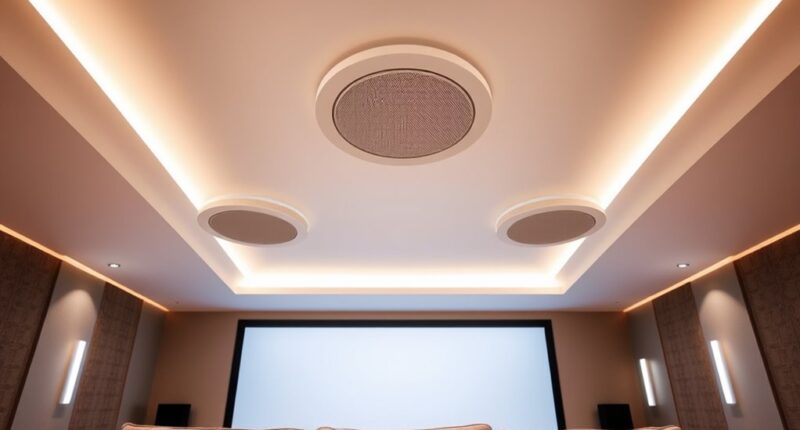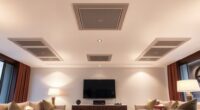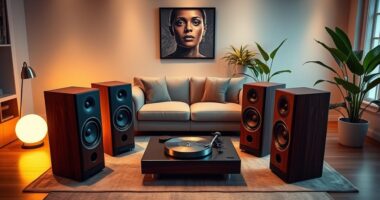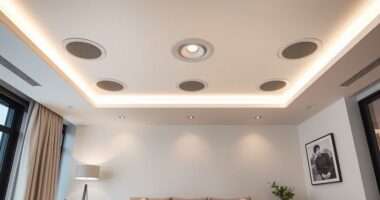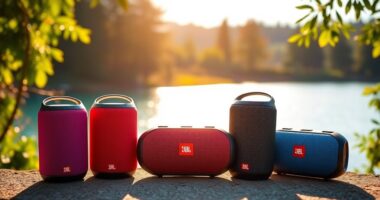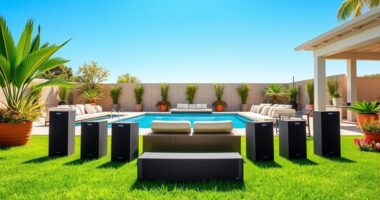To elevate your home audio experience, consider the Acoustic Audio CS-IC83, known for its exceptional sound quality and power handling, making it ideal for Dolby Atmos setups. The Micca M-8C offers a solid 2-way design, providing good sound at an affordable price. Finally, Pyle 6.5 speakers are great for those on a budget, delivering clear audio for background music. Each option caters to different needs, ensuring you find the right fit for your space. Explore these choices further for more details.
At a Glance
- Acoustic Audio CS-IC83: Offers exceptional sound quality with a wide frequency response of 40Hz to 20kHz, ideal for immersive Dolby Atmos setups.
- Micca M-8C: Features a high-quality 8-inch woofer and 1-inch tweeter, providing clear sound reproduction suitable for home theaters and multi-room audio.
- Pyle 6.5: An affordable option for background music, with a frequency response of 65Hz to 22kHz, enhancing sound clarity in budget setups.
- Sensitivity Ratings: Look for speakers with ratings above 90dB to ensure efficient sound performance at lower power levels, essential for dynamic playback.
- Installation Considerations: Ensure models have built-in mounting tabs and appropriate cut-out sizes for easy installation in various ceiling configurations.
Acoustic Audio CS-IC83 in Ceiling 8 Speaker Pair Pack
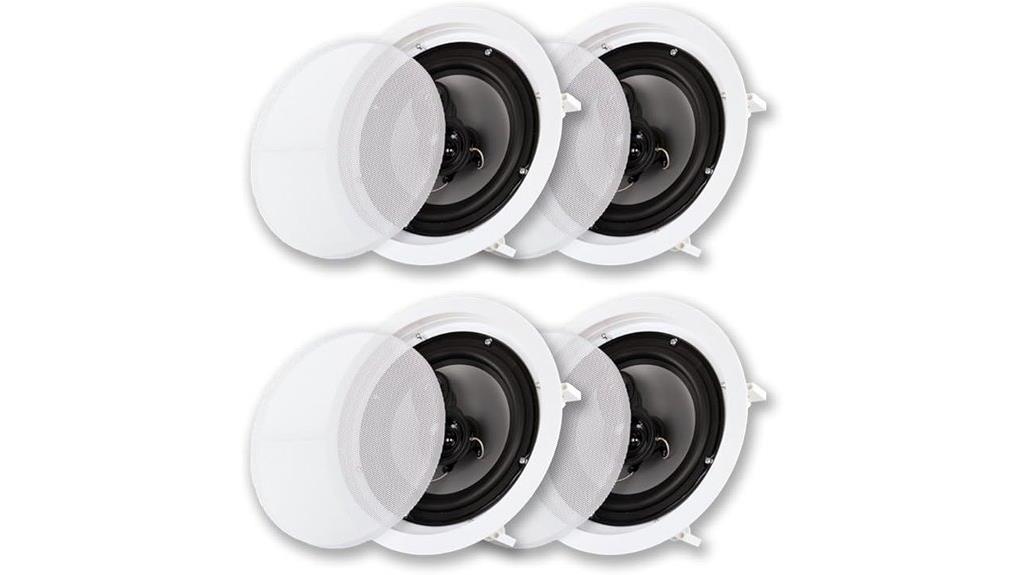
The Acoustic Audio CS-IC83 In-Ceiling Speaker Pair Pack is an excellent choice for anyone looking to enhance their home theater experience. These 3-way speakers handle 20-350 watts each, delivering a total of 1400 watts. With a frequency response from 40Hz to 20kHz, you’ll enjoy deep bass and clear highs. Their 95dB efficiency guarantees impressive sound quality even at higher volumes. Weighing just 3.75 pounds, they’re easy to install and come with paintable grills, blending seamlessly into your decor. Ideal for various settings, these speakers connect easily to your devices, making them a versatile addition to your audio setup.
Best For: Those seeking high-quality in-ceiling speakers for home theater systems, outdoor areas, or multi-room audio setups.
Pros:
- Exceptional sound quality with crisp highs, clear mids, and deep bass performance.
- Versatile connectivity options compatible with various devices including smartphones, tablets, and televisions.
- Easy installation with included instructions and paintable grills for seamless integration into your decor.
Cons:
- Some users may require a grill-removal tool for easier installation.
- Limited bass performance in very large spaces may require additional subwoofers for optimal sound.
- Wired connectivity only may not suit those preferring wireless speaker options.
Micca M-8C 2-Way in-Ceiling Round Speaker
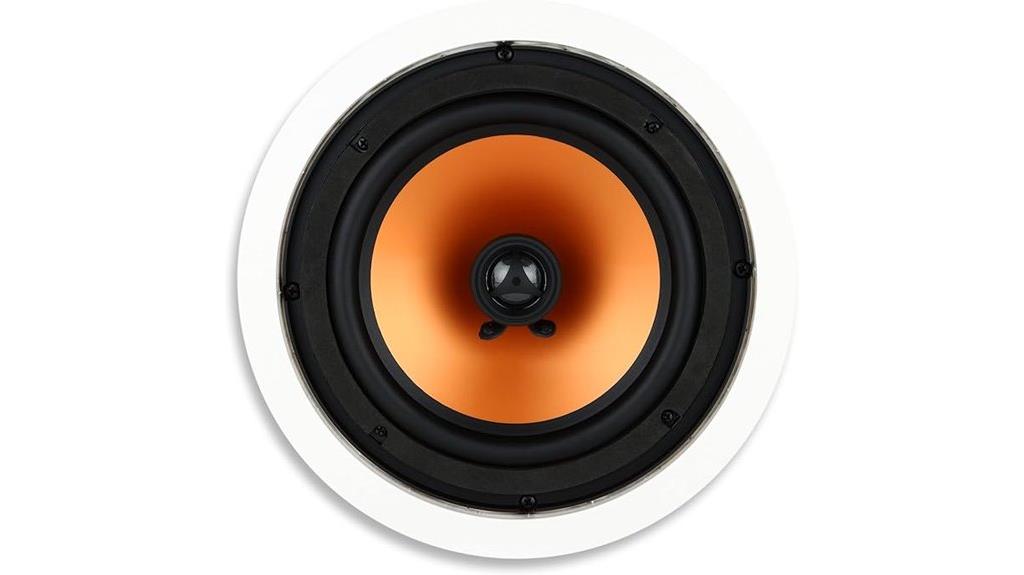
For those seeking a seamless audio experience in their home theater or multi-room audio systems, the Micca M-8C 2-Way in-Ceiling Round Speaker stands out as an excellent choice. Featuring an 8-inch poly woofer and a 1-inch silk dome tweeter, it delivers a frequency response of 40Hz to 20kHz. With a cutout diameter of 9.4 inches and a mounting depth of 3.5 inches, installation is straightforward thanks to built-in mounting tabs. Weighing just 3.6 pounds, it fits easily in various rooms. Users appreciate its high sound quality and robust bass, making it an ideal option for your audio needs.
Best For: Those seeking an affordable, high-quality in-ceiling speaker for home theaters and multi-room audio systems.
Pros:
- Exceptional sound quality across various music genres with robust bass output.
- Easy installation with built-in mounting tabs, eliminating the need for additional brackets.
- Cost-effective alternative to more expensive brands like Polk, Yamaha, and Bose.
Cons:
- Some users have reported sound transmission issues through walls and floors.
- May not meet the needs of users seeking extreme volume levels.
- Requires sufficient space for mounting due to the cutout and depth dimensions.
Pyle 6.5 In-Wall/In-Ceiling Midbass Speakers (Pair)
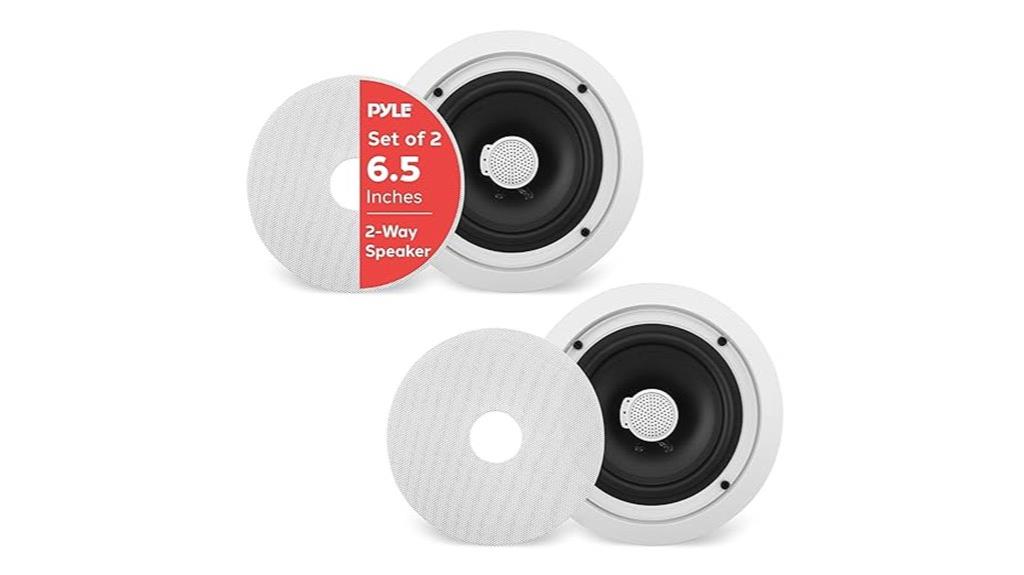
Pyle’s 6.5 In-Wall/In-Ceiling Midbass Speakers (Pair) are an excellent choice for anyone seeking budget-friendly audio solutions that deliver solid performance for background music and general listening. With a flush mount design and a 2-way woofer system, these speakers provide a frequency response of 65Hz to 22kHz. They can handle up to 250 watts peak power, making them suitable for various audio applications. Installation is straightforward, thanks to the included cut-out template and convenient speaker terminals. Users appreciate the clear sound quality and responsiveness, especially for whole-house audio systems and less demanding environments.
Best For: Budget-conscious consumers looking for reliable in-wall or in-ceiling speakers for background music and general listening.
Pros:
- Clear sound quality with good responsiveness, ideal for whole-house audio systems.
- Easy installation with included cut-out template and convenient speaker terminals.
- Affordable price point, making them a strong value option for budget installations.
Cons:
- Not suitable for high-power home theater systems or audiophile standards.
- Bass response may not be as deep as higher-end models.
- Treble may be less pronounced, which may not appeal to all users.
Factors to Consider When Choosing In Ceiling Speakers for Atmos
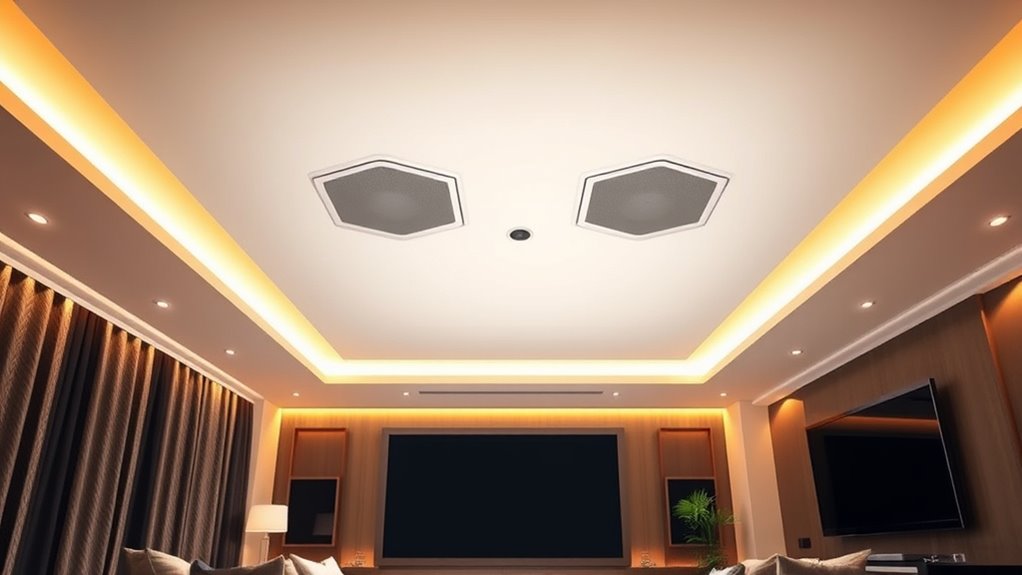
When choosing in-ceiling speakers for Atmos, you should consider several important factors to guarantee peak performance. Look at the speaker configuration types, frequency response range, and power handling capacity to match your audio needs. Additionally, think about installation ease and sound quality performance to achieve a seamless audio experience in your space.
Speaker Configuration Types
Choosing the right speaker configuration is essential for achieving an immersive audio experience in your home theater, especially for Dolby Atmos setups. In-ceiling speakers come in various designs, including 2-way, 3-way, and 4-way configurations. A 3-way configuration typically offers a better balance of bass, midrange, and treble, enhancing overall sound quality. Consider the power handling capacity, as some speakers manage between 20-350 watts, affecting volume and clarity. Impedance ratings usually range from 4 to 8 ohms, with 8-ohm speakers being more common and ensuring compatibility with most amplifiers. Additionally, look for higher sensitivity ratings, around 90 dB or above, which allow for louder volumes without needing excessive power, contributing to a more enjoyable audio experience.
Frequency Response Range
To achieve an immersive audio experience with in-ceiling speakers for Dolby Atmos, understanding the frequency response range is essential. Ideally, look for speakers that cover a range of 40Hz to 20kHz. This range allows for deep bass, enhancing the atmospheric quality of sound in your home theater. A lower limit of 40Hz helps produce that rich bass you desire, while the upper limit guarantees clarity and detail in high-pitched sounds, like cymbals and vocals. Choosing speakers with a wider frequency response gives you a more versatile sound profile, accommodating different music genres and audio formats. Finally, make certain the frequency response of the speakers matches your playback system for peak sound performance across various sources.
Power Handling Capacity
Power handling capacity is a vital factor in selecting in-ceiling speakers for an immersive Dolby Atmos experience. This capacity indicates the maximum power a speaker can handle, typically measured in watts, ranging from 100 to over 350 watts for higher-end models. A speaker’s power handling is vital for producing clear sound without distortion, especially at higher volumes during dynamic audio playback. If you choose speakers with a higher power handling capacity, you’ll likely achieve better performance in larger spaces, where elevated sound levels are necessary. It’s essential to match the power handling of your speakers with your amplifier’s output to avoid damaging them. Speakers with higher capacities often feature better components, enhancing overall sound quality.
Installation Ease Factors
When setting up in-ceiling speakers for an immersive Dolby Atmos experience, installation ease is just as important as power handling capacity. Look for speakers with built-in mounting tabs or templates to simplify the process and guarantee a secure fit in drywall or wood panels. Consider the mounting depth; some models require more space behind the ceiling, ranging from 2.75 to 3.78 inches. Make sure the cut-out size aligns with your installation area, typically around 9.4 to 9.45 inches in diameter. Choose speakers that come with installation manuals and guides to assist you, reducing potential errors. Opt for options with spring-loaded or convenient wire terminals, which make quick and easy wire connections during setup.
Sound Quality Performance
Sound quality performance is a critical factor to contemplate when selecting in-ceiling speakers for a Dolby Atmos setup. Ideally, look for speakers with a frequency response between 40Hz and 20kHz to capture both deep bass and crisp highs. Pay attention to sensitivity ratings, aiming for above 90dB, as this indicates better sound quality at lower power levels. A well-designed crossover network, like a 6dB or 12dB per octave slope, guarantees smooth integration of woofers and tweeters, enhancing clarity. Additionally, check the power handling capabilities to match your amplifier’s output, preventing distortion during high-volume playback. Finally, materials such as polypropylene cones and silk dome tweeters can greatly improve sound quality and durability.
Frequently Asked Questions
Can In-Ceiling Speakers Be Used for Outdoor Applications?
Yes, you can use in-ceiling speakers for outdoor applications, but make certain they’re weather-resistant. Installing them properly protects against moisture and temperature fluctuations, enhancing your outdoor audio experience while maintaining sound quality and durability.
How Do I Install In-Ceiling Speakers Myself?
Why not tackle the installation yourself? Start by choosing the right location, cutting the holes, and connecting wires. Secure the speakers and test the sound. You’ll enjoy the satisfaction of your own handiwork!
What Is the Ideal Height for Mounting In-Ceiling Speakers?
You should mount in-ceiling speakers about 7 to 9 feet high for ideal sound quality. This height allows for better sound dispersion and guarantees an immersive audio experience without overwhelming your space. Adjust based on room specifics.
Are In-Ceiling Speakers Compatible With All Audio Systems?
Like a chameleon blending into its environment, in-ceiling speakers can fit into most audio systems. They’re versatile, but you’ll want to check compatibility with your receiver to guarantee seamless sound and performance.
How Do I Determine the Number of Speakers Needed for My Room?
To determine how many speakers you need, consider your room size and layout. Generally, aim for one speaker per 100 square feet, but adjust based on your listening preferences and desired sound quality.
Conclusion
Ultimately, choosing the right in-ceiling speakers for your Atmos setup can greatly enhance your home audio experience. The Acoustic Audio CS-IC83, Micca M-8C, and Pyle speakers each offer unique features to suit different preferences. As you explore these options, remember to take into account factors like sound quality, installation ease, and design. With the right speakers, you can create an immersive audio environment, reminiscent of the golden age of cinema, right in your own living room.
